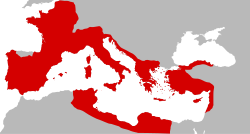
Back Romeinse Republiek Afrikaans Römische Republik ALS Republica Romana AN Romanisc Cynewise ANG الجمهورية الرومانية Arabic الجمهوريه الرومانيه ARZ República Romana AST Romafe Sokasane AVK Roma Respublikası Azerbaijani روم جومهوریتی AZB
Roman Republic Res publica Romana | |||||||||
|---|---|---|---|---|---|---|---|---|---|
| c. 509 BC–27 BC | |||||||||
Denarius of 54 BC, showing the first Roman consul, Lucius Junius Brutus, surrounded by two lictors and preceded by an accensus.[1]
| |||||||||
 Roman provinces on the eve of the assassination of Julius Caesar, 44 BC | |||||||||
| Capital | Rome | ||||||||
| Official languages | Latin | ||||||||
| Religion | Roman polytheism | ||||||||
| Demonym(s) | Roman | ||||||||
| Government | Consular republic | ||||||||
| Consuls | |||||||||
• 509 BC (first) | |||||||||
• 27 BC (last) | |||||||||
| Legislature | Assemblies | ||||||||
| Historical era | Classical antiquity | ||||||||
| c. 509 BC | |||||||||
• Dissolution of the Latin League | 338 BC[2] | ||||||||
| 82 BC | |||||||||
• Julius Caesar named dictator for life | February 44 BC | ||||||||
| 15 March 44 BC | |||||||||
| 2 September 31 BC | |||||||||
| 16 January 27 BC | |||||||||
| Area | |||||||||
| 326 BC[3] | 10,000 km2 (3,900 sq mi) | ||||||||
| 50 BC[3] | 1,950,000 km2 (750,000 sq mi) | ||||||||
| |||||||||
The Roman Republic (Latin: Res publica Romana [ˈreːs ˈpuːblɪka roːˈmaːna]) was the era of classical Roman civilization beginning with the overthrow of the Roman Kingdom (traditionally dated to 509 BC) and ending in 27 BC with the establishment of the Roman Empire. During this period, Rome's control expanded from the city's immediate surroundings to hegemony over the entire Mediterranean world.
Roman society at the time was primarily a cultural mix of Latin and Etruscan societies, as well as of Sabine, Oscan, and Greek cultural elements, which is especially visible in the Ancient Roman religion and its Pantheon. Its political organization developed at around the same time as direct democracy in Ancient Greece, with collective and annual magistracies, overseen by a senate.[4] There were annual elections, but the republican system was an elective oligarchy, not a democracy; a small number of powerful families largely monopolised the magistracies. Roman institutions underwent considerable changes throughout the Republic to adapt to the difficulties it faced, such as the creation of promagistracies to rule its conquered provinces, or the composition of the senate.
Unlike the Pax Romana of the Roman Empire, throughout the republican era Rome was in a state of quasi-perpetual war. Its first enemies were its Latin and Etruscan neighbours, as well as the Gauls, who sacked Rome in 387 BC. After the Gallic sack, Rome conquered the whole Italian peninsula in a century and thus became a major power in the Mediterranean. Its greatest strategic rival was Carthage, against which it waged three wars. Rome defeated Carthage at the Battle of Zama in 202 BC, becoming the dominant power of the ancient Mediterranean world. It then embarked on a long series of difficult conquests, defeating Philip V and Perseus of Macedon, Antiochus III of the Seleucid Empire, the Lusitanian Viriathus, the Numidian Jugurtha, the Pontic king Mithridates VI, Vercingetorix of the Arverni tribe of Gaul, and the Egyptian queen Cleopatra.
At home, during the Conflict of the Orders, the patricians, the closed oligarchic elite, came into conflict with the more numerous plebs; this was resolved peacefully, with the plebs achieving political equality by the 4th century BC. The late Republic, from 133 BC onward, saw substantial domestic strife, often anachronistically seen as a conflict between optimates and populares, referring to conservative and reformist politicians, respectively. The Social War between Rome and its Italian allies over citizenship and Roman hegemony in Italy greatly expanded the scope of civil violence. Mass slavery also contributed to three Servile Wars. Tensions at home coupled with ambitions abroad led to further civil wars. The first involved Marius and Sulla. After a generation, the Republic fell into civil war again in 49 BC between Julius Caesar and Pompey. Despite his victory and appointment as dictator for life, Caesar was assassinated in 44 BC. Caesar's heir Octavian and lieutenant Mark Antony defeated Caesar's assassins in 42 BC, but they eventually split. Antony's defeat alongside his ally and lover Cleopatra at the Battle of Actium in 31 BC, and the Senate's grant of extraordinary powers to Octavian as Augustus in 27 BC—which effectively made him the first Roman emperor—marked the end of the Republic.
- ^ Crawford 1974, pp. 455, 456.
- ^ Latin League.
- ^ a b Taagepera 1979.
- ^ Momigliano 1989, pp. 110–11.
